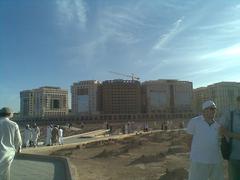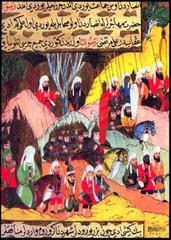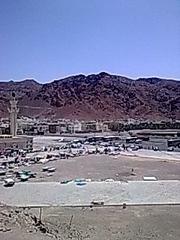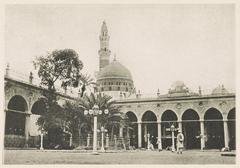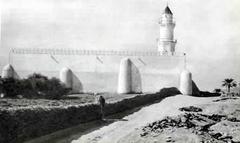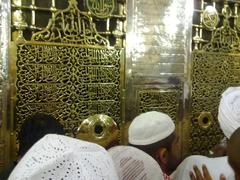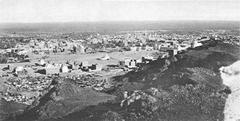Mosque of Atban Bin Malik: Visiting Hours, Tickets, and Medina Historical Sites Guide
Date: 04/07/2025
Introduction
The Mosque of Atban Bin Malik in Medina, Saudi Arabia, is a living testament to the formative years of Islam. Deeply tied to the Prophet Muhammad (PBUH) and his companions, this historic mosque preserves the humble spirit and communal ethos of early Muslim prayer spaces. Unlike the grander mosques of Medina, Atban Bin Malik’s mosque stands out for its simplicity, authenticity, and spiritual significance, offering visitors a unique perspective on Medina’s sacred landscape. This guide provides a comprehensive overview—including historical background, visiting details, architectural features, and practical travel tips—to ensure a respectful and enriching experience for all who wish to explore this remarkable site (behalaltravels.com; islamiclandmarks.com; learnreligions.com).
Historical and Religious Background
The Story of Atban Bin Malik
Atban Bin Malik was a respected companion of the Prophet Muhammad (PBUH) and a member of the Ansar—the indigenous Medinan supporters of the Prophet following his migration from Mecca in 622 CE. According to authentic traditions, Atban, who became visually impaired in his later years, requested that the Prophet visit his home and pray in a particular spot. The Prophet, accompanied by Abu Bakr (RA), accepted this invitation and led a prayer in Atban’s house, sanctifying the location. This space was subsequently established as a mosque, symbolizing Prophetic blessing and the intimate nature of early Islamic worship (islamiclandmarks.com; learnreligions.com).
Key Takeaways:
- Personal Worship: Early mosques often began in private homes, reflecting communal accessibility.
- Prophetic Tradition: The Prophet’s act of praying at specific sites imparted enduring spiritual significance.
- Community Unity: The mosque became a focal point for local worship and social cohesion.
Medina’s Spiritual Significance
Medina, historically known as Yathrib, is central to Islam’s development. The city became the heart of the first Islamic community and state after the Hijrah, with numerous mosques established to foster worship and learning (behalaltravels.com). While Al-Masjid an-Nabawi and Quba Mosque are the most prominent, smaller mosques like that of Atban Bin Malik showcase the inclusivity and accessibility of early Islamic religious practice.
Architectural Features and Preservation
The Mosque of Atban Bin Malik epitomizes early Islamic architectural humility. Its original structure consisted of a small, rectangular prayer hall built with local stone, mudbrick, and timber—materials typical of 7th-century Medina (iqrasense.com). Over the centuries, the mosque has undergone careful renovation, preserving its modest scale and essential functions:
- Simple Prayer Hall: Focused on utility, with minimal ornamentation.
- Mihrab: A niche marking the qibla (direction of prayer).
- Unadorned Interior: Reflecting the ascetic values of early Islamic architecture.
Traditional preservation techniques have maintained the building’s authenticity, while occasional updates ensure structural safety and accessibility (HelloTravel; Madain Project).
Location and Accessibility
Geographic Setting
The mosque is located in the Al Awali district, southeast of Al-Masjid an-Nabawi, with coordinates 24.4342° N, 39.6177° E (Google Maps). Its placement in a residential neighborhood offers authentic insight into daily life in Medina and is proximate to other historic mosques such as Quba and Al Jum’ah.
Getting There
- By Car or Taxi: 10–15 minutes from the city center via King Abdullah Road; ride-hailing services available.
- Public Transport: SAPTCO buses serve the district; nearest stop is 400 meters away.
- On Foot: Pedestrian-friendly for nearby visitors; ideal during cooler months (November–March).
Visiting Hours, Admission, and Etiquette
- Opening Hours: Open daily from dawn until after the night prayer (approx. 8:00 AM–7:00 PM outside prayer times). Hours may vary during Ramadan and holidays.
- Admission: Free; no ticket required.
- Entry Policy: Muslims may access the prayer hall, while non-Muslims can appreciate the mosque from the exterior and participate in guided historical tours (thetravelersbuddy.com).
- Dress Code: Modest clothing for all visitors; women should wear an abaya and headscarf, men should cover arms and legs.
- Behavior: Remove shoes before entering; maintain silence and avoid photography during prayers without permission.
Facilities and Visitor Support
- Prayer Halls: Separate areas for men and women; basic ablution facilities.
- Accessibility: Ramps and wide doorways for wheelchair users.
- Amenities: Nearby cafes, rest areas, grocery stores, and pharmacies.
- Language Support: Signage in Arabic and English; helpful staff, especially during pilgrimage seasons.
- Tourist Assistance: Medina Tourism Office near Al-Masjid an-Nabawi provides maps, brochures, and multilingual help (Saudi Tourism Authority).
Nearby Historical and Religious Sites
- Al-Masjid an-Nabawi: The Prophet’s Mosque, central to Medina’s spiritual landscape.
- Quba Mosque: The oldest mosque in Islam.
- Al Jum’ah Mosque: Historic mosque north of Atban Bin Malik.
- Masjid Al-Qiblatain: Noted for its two qiblas.
- Mount Uhud: Site of a major early Islamic battle.
Combining visits to these landmarks enriches understanding of Medina’s pivotal role in Islamic history (General Authority for Islamic Affairs).
Practical Tips
- Best Times: November–March for mild weather; weekday mornings or afternoons for quiet visits.
- Guided Tours: Available via local operators, especially during Hajj and Umrah seasons.
- Transport: Use taxis or ride-hailing apps for convenience.
- Photography: Respect local customs—ask before photographing, especially inside.
- Travel Resources: Audiala app and official Medina tourism websites for updated information.
Frequently Asked Questions (FAQ)
Q: What are the mosque’s visiting hours?
A: Open daily from dawn until after the evening prayer; check locally for variations during holidays.
Q: Is there an entrance fee?
A: No. Entry is free.
Q: Can non-Muslims enter?
A: Non-Muslims are typically restricted from entering the prayer hall but may view the mosque and join external tours.
Q: Is the mosque wheelchair accessible?
A: Yes; ramps and wide entrances are provided.
Q: Are guided tours available?
A: Yes, especially during peak pilgrimage times; booking in advance is recommended.
Visuals and Media Suggestions
Enhance your experience with high-quality images (e.g., “Mosque of Atban Bin Malik exterior in Medina”), interactive maps, and virtual tours available via official tourism platforms and travel apps.
Summary and Final Thoughts
The Mosque of Atban Bin Malik remains an enduring symbol of Islamic humility, devotion, and community. Its historical significance, architectural authenticity, and tranquil setting make it a vital stop for pilgrims, historians, and spiritual seekers in Medina. Visitors gain a deeper appreciation for the Prophet’s personal connections with his companions and the evolution of Muslim communal life.
To maximize your visit, plan ahead, respect local customs, and explore Medina’s other historic sites. Download the Audiala app for the latest information, guided tours, and resources to enrich your journey through Medina’s sacred heritage.
For further details and updates, consult official Medina tourism resources and the platforms referenced below.
Sources and Further Reading
- The Significance of Medina in Islam, 2024, BeHalal Travels
- Mosque of Atban Bin Malik, Islamic Landmarks
- Madinah City Guide, Learn Religions
- Mosques in Medina Saudi Arabia, Regency Holidays Blog
- Can Non-Muslims Visit Medina? The Travelers Buddy, 2024
- Mosque of Atban Bin Malik – Wikipedia
- Trek Zone
- Madain Project
- HelloTravel
- Saudi Tourism Authority
- General Authority for Islamic Affairs
- Academia.edu
- Mosqpedia PDF
- Scribd
- The Wandering Quinn
